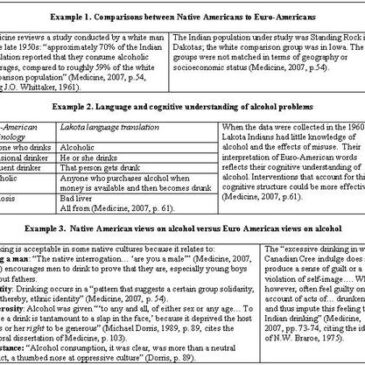Scientific research focusing on addiction, especially research on effective interventions and treatments, is typically grounded in the disciplines of psychology, psychiatry, and other behavioral sciences. An important but less frequently used guide could be cultural anthropology, especially when researchers explore cultures other than their own. This issue of Addictions and the Humanities will explore how cultural anthropology raises psychological scientists’ awareness about cultural context, and how this awareness is essential to advance meaningful research.
Beatrice Medicine, a member of the Lakota Indian tribe, was a cultural anthropologist who spent her life writing and studying Native Americans, particularly those living on her reservation in North and South Dakota.
Medicine’s posthumously published Drinking and Sobriety among the Lakota Sioux shows differences between Native and Euro-American perspectives about drinking and problem drinking. She maintained that research and interventions conducted by those unfamiliar with the Sioux were not sufficiently culturally specific to be socially relevant or effective enough to make a meaningful impact.
Table 1 summarizes examples of three miscommunications that have occurred between cultures during the past sixty years.
Table 1. Cultural context clashes with Euro-American centered approaches to studying Native American drinking patterns.
(Click image to enlarge.)
Medicine suggests that comparing Native American drinking to Euro-American drinking is unfair because drinking fits into each culture differently. The effect, then, is that Euro-Americans view drinking as a problem to eliminate. Among some Indian groups, however, it is an entity too entrenched to blindly dismantle. This “‘problem’ approach [that] has superseded most other approaches” (Medicine, 2007, p. 15) not only supersedes, but excludes them. Limited knowledge of Native American culture limits the effectiveness of interventions.
Medicine wrote her book decades ago; it was published posthumously, therefore, the bulk of the evidence that supports her arguments dates from the 1960s–1980s. The impact of Medicine’s research over the decades is difficult to measure. However, there is evidence that some modern researchers have become more culturally sensitive with time (e.g., Marlatt et al., 2003). By being watchful, researchers have limited the problem. Medicine’s work focuses on alcohol’s cultural context, but we must keep in mind that culture is dynamic. Therefore, the strength of this book lies not in its specific culture-related information, but rather in the awareness it promotes regarding the importance of cultural context for psychological research.
Medicine’s cultural anthropologic approach places drinking problems among the Lakota Indians into context. Her exploration of alcohol in Native American history detangles the substance’s foundation within the culture. A cultural anthropological approach, therefore, can help psychological researchers ask relevant questions and design sensitive studies that will effectively and accurately reflect the population under study. It also can encourage cooperative partnerships between cultures to address alcohol problems within Native American communities.
What do you think? Comments can be addressed to Leslie Bosworth.
References
Braroe, N.W. (1975). Indian and White. Stanford, Calif: Stanford University Press.
Dorris, M. (1989). Broken Cord. New York: Harper Perennial.
Medicine. An Ethnography of Drinking and Sobriety Among the Lakota Sioux. Doctoral Dissertation, University of Wisconsin at Madison.
Marlatt, G. A., Larimer, M. E., Mail, P. D., Hawkins, E. H., Cummins, L. H., Blume, A. W., et al. (2003). Journeys of the circle: A culturally congruent life skills intervention for adolescent Indian drinking. Alcoholism: Clinical and Experimental Research, 27(8), 1327-1329.
Medicine, B. (2007). Drinking and sobriety among the Lakota Sioux. Lanham: Altamira Press.
Whittaker, J.O. (1961). Alcohol and the Standing Rock Sioux tribe. Fort Yates, North Dakota: Commission on Alcohol Standing Rock Sioux Tribe.






james77 October 15, 2008
I can really relate to this article as I’m a Native American who has struggled with alcoholism for a very long time. Treatment for me has been more beneficial when conducted with other people who share the same culture as me. Although I am only one person, this study really hits home with me and my struggles and explains many things to me.
Richard Lee April 28, 2016
Dr Bosworth,
The article on cultural sensitivity & alcohol research was of interest to me partly because I have some sympathy with Dr Beatrice Medicine’s attempt to stand up for her own culture in the face of a more dominant one. There are obvious differences that have developed historically between US & UK views & theoretical models of alcohol use, misuse & addiction but one powerful way North American therapeutic hegemony exerts its influence is via celebrity culture of rehab memoirs which can colour the way problem drinking is discussed, creating needless distractions.
However, the aspect of this article that surprised me most was that drinking was acceptable at all in Native cultures. I had assumed, wrongly it turns out, that Native Americans would reject alcohol, in principal at least, as a means by which Europeans tried to contain their culture.
Regards,
Richard Lee, CPN
Options CSMS ~ Alcohol Team
West Sussex
United Kingdom